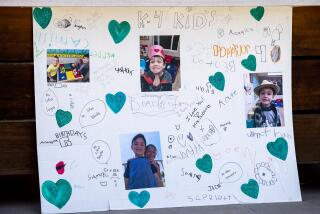How to deal with drivers on cellphones
Re: [“Is It a Safer Call?” June 30], you cite scientists who claim that drivers’ attention and processing capacities are “often stretched beyond safe limits when someone juggles the complex tasks of negotiating traffic and conversing with another remotely.”
The remoteness of the person one is talking to has nothing to do with the distraction factor. How is talking to my wife via cellphone while driving any more distracting than talking to her as she sits in the car with me? How is it more distracting to talk to my wife remotely than to listen to the radio or a CD while driving?
If I leave the house for the office after having a fight with my wife, and all those feelings are going through me and I’m replaying the conversation in my head, thinking of all the things I should have said, is that less distracting than “talking remotely” via cellphone?
How idiotic!
If we honor the spirit of these scientists’ findings, then we must drive alone or in silence, not play the radio or music while driving, take a mandatory cooling-off period of at least one hour before leaving the house to drive after a fight with one’s spouse.
Does this sound as absurd to you as it does to me? I sure hope so.
Mitchell Harris
La Verne
In light of the scientific evidence set forth in the article that cellphone-using drivers (both hand-held and hands-free) have an 18% slower reaction time than drivers over the legal intoxication limit, and that they compensate for this by slowing down, exacerbating traffic congestion in the process, I propose formation of a new version of MADD to be called Motorists Against Distracted Drivers.
Any such cellphone-chatting drivers who get busted (whether or not an accident is involved) should be subjected to penalties equivalent to those imposed on drunk drivers, such as 48 hours in jail, community service (roadside trash pickup in orange vests, with no cellphones while doing so), huge fines, huge insurance rate increases, and weekly meetings for a year on the dangers of driving while cellphoning. They need to be stigmatized every bit as much as busted drunk drivers.
It’s very simple folks: When you get in the car, turn off the phone. And when you get to your destination, you can check your voicemail for any calls that may have come in while you were driving. Please keep your hands on the wheel and keep your eyes and your mind on the road.
Richard Strassman
San Diego
The new ban on hand-held phoning while driving is a political and commercial fraud. The governor and legislature claim to have improved safety while they have not done so, claiming to be responsible for the public safety while really satisfying “phone-y” drivers and cellphone manufacturers who will make more money selling new hands-free devices.
Surely the politicians knew that hands-free phones are no safer than hand-held ones and that they will still make drivers four times more likely to have an accident. But, hey, banning all phoning when driving (the obvious safety measure) would inconvenience voters and cut down on cellphone sales.
Politicians are in business to get reelected and to please business contributors, not to pass sensible and effective laws.
David Eggenschwiler
Los Angeles
This is something I have agreed with for years -- that talking takes far more attention than listening (which you can tune out when you need to pay attention to something else). When I’m preparing food, and am in the middle of having something on the stove, I can listen and cook, but every time I try to talk and cook, I burn the food.
It is easy for me to drive and listen to the radio, or to someone talking. But talking back to the person takes far more of my concentration.
I would be tempted to say that it doesn’t take any special research to know [these things], but I can see the research is necessary to convince others. Nevertheless, I don’t think most people’s behavior will change, because I don’t think most people care as much about safety as they do about convenience.
I subscribe to the L.A. Times on my RSS reader, and it’s what I read first, every day, in Morocco.
Mary Duckworth Demis Mimouna
Marrakesh, Morocco
Very good piece on the cellphone issue. Driving is a “doing” activity, one in which the mind needs mental space but not necessarily mental engagement. A phone conversation is a “thinking” thing. Most drivers will not let go of the phone or stop talking so as to concentrate on an emergency driving moment.
Now if we could just get people to use turn signals . . .
Bill Orton)
Long Beach
As a motorcyclist who has had a number of close calls with cellphone users, I say anything that increases an automobile driver’s ability to see me in his/her peripheral vision is an improvement.
Holding a phone up to the side of your face when driving blocks your view of the adjacent lane, sometimes with potentially disastrous consequences.
Now if the Legislature could do something about Volvo drivers and their complacency because of their perceived physical invincibility, the roads would be a lot safer.
Eric Kretschmer
Los Angeles
We appreciated the L.A. Times’ detailed article focusing on the research around cellphone use while driving. The experience of state highway safety agencies matches the research cited in the article -- all cellphone use is distracting.
The best advice to drivers is to hang up and drive -- no matter what the law says.
Jonathan Adkins
Communications Director, Governors Highway Safety Assn.
Washington, D.C.
Just common sense says to me that a person is more likely to be distracted by passengers, what with craning the neck around to look at them, to peer at their faces for more meaning than just words.
What about a dog in the car, leaping all about?
How about a screechingly funny “Prairie Home Companion” -- or worse, a shock jock on the radio?
How about hot coffee sloshing into laps?
Wouldn’t a cellphone conversation rank at the bottom of these events, or is there something I’m missing in all of this scientific background noise about the distraction of listening to language?
It also seems abundantly clear to me that when you have an arm up to your ear, you have blocked a considerable portion of your view to either right or left, which is not the case with hands-free. So I would be interested to know if that was addressed.
Larry Dunlap Woodland Hills
I disagree with those who say hands-free devices will not reduce traffic accidents.
In the article there is this quote: “a driver’s attention and processing capacity . . . are often stretched beyond safe limits when someone juggles the complex tasks of negotiating traffic and conversing with another remotely.”
It is my experience as a pilot that this is not true. For instance, when flying from point A to point B, I am in contact with several agencies. On departure, I talk to the local tower for take-off clearance, often while taxiing. After takeoff, the tower may transfer me to a Center frequency for further routing. In flight, I am in contact with Air Traffic Control, and on approach to my destination, I am again talking to Center, Arrival and Tower during a very busy time in the cockpit.
This is normal procedure for all pilots whether small single-engine airplanes or multi-engine airliners. We are flying the plane, looking for other traffic and talking to the various controlling agencies on the radios all at the same time.
Our processing capabilities are not stretched to the limit. This is normal operation.
If you are going to allow people to listen to the radio in their cars, you are pretty much going to have to allow them to use their cellphones. The hands-free devices make that task safer.
Ron Kelley
Chatsworth
I’ve been following this topic for years, since cellphones came into wide use among motorists.
You may be aware of a fascinating experiment by psychologist Daniel Simons that was described in the New Yorker (June 11, 2001). It demonstrated the degree to which a person’s attention can be diverted. Subjects were asked to count the number of times that constantly moving basketball players wearing white shirts passed two basketballs to players in black shirts. The activity was videotaped. Forty-five seconds into the activity, a woman in a gorilla suit walked into the middle of the players, stood in front of the camera, and beat her chest before walking away -- and half the subjects afterward reported that they had not even noticed the gorilla.
When their attention is engaged, people “see” what they expect to see, and fail to see the unexpected -- even if the activity occurs within their field of vision. In the case of a driver whose attention is diverted by use of a cellphone, just replace the gorilla in the above scenario with a pedestrian in a crosswalk.
Jack McCain
Durham, Conn.
A more personal trainer can help
Re: [ “Trying to Reclaim the Rhythm of Her Life,” June 30] please tell Linda Alcorace that she should dump that sadistic aerobics instructor and get a very competent personal trainer who can help her develop muscle strength safely. She cannot get the personal assistance she needs in a class.
I am not a trainer, but am the grateful recipient and beneficiary of several years of personal training that have helped me gain strength, work through several injuries and develop better balance and increased stamina. By the way, aerobics classes do not build muscle mass; weight lifting does.
I hope you get your transplant soon. While waiting, take better care of yourself.
Judy Fenton
Costa Mesa
I read this article with considerable empathy and sadness for Linda. There is a cardiopulmonary rehabilitation program at UCLA that does what she needs for people seeking heart or lung transplants, post-transplant, or with heart or lung disease. In a supportive atmosphere, with registered nurses and respiratory therapists directing the exercise program, one can build up strength and muscle slowly, being monitored for blood pressure, heart rate, oxygen saturation, etc.
I have been going three days a week for eight months and feel much stronger and better. It is a pity there isn’t something equivalent for liver-transplant patients.
Carole Cochran
Playa del Rey
Letters should be brief and must include the writer’s name, address and phone numbers. No pseudonyms. Letters are subject to editing and condensation. Mail to Letters in Health, Los Angeles Times, 202 W. 1st St., Los Angeles, CA 90012; or e-mail to [email protected].






